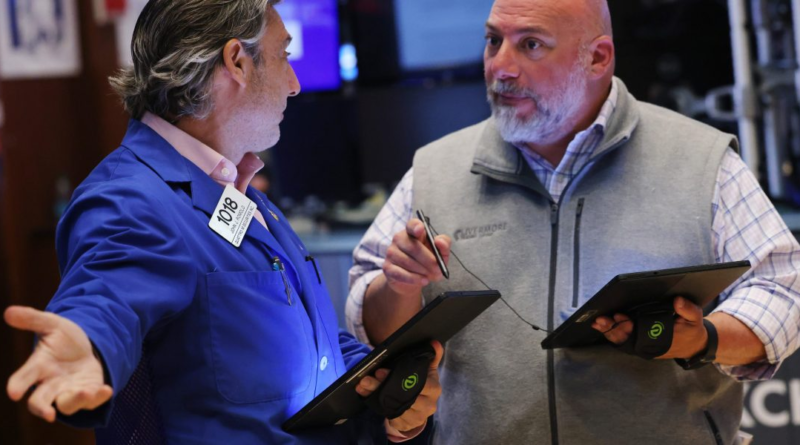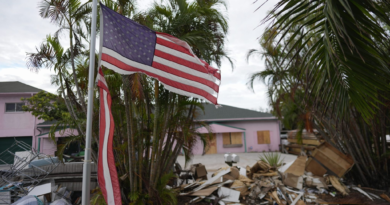A shrinking service economy and rising jobless claims send S&P 500 to record high ahead of July 4 holiday
Wall Street traders sent stocks higher as bonds yields fell after a string of weaker-than-estimated economic reports reinforced the case for the Federal Reserve to start cutting rates this year.
In a shortened session ahead of the US holiday, the S&P 500 hit an all-time high on bets lower rates will keep fueling Corporate America. Treasuries climbed across the curve. The dollar remained lower after minutes from the June Fed policy gathering showed officials were awaiting evidence that inflation is cooling and were divided on how long to keep rates elevated.
To Paul Ashworth at Capital Economics, the Fed minutes “feel dated” given subsequent signs of an economic slowdown. Michael Feroli at JPMorgan Chase & Co. said the minutes “lean dovish.” There was broad agreement that disinflationary pressures are prevalent, that the labor market is getting less tight, and that economic activity growth should continue moderating, he noted.
In the run-up to Friday’s jobs report, data showed the services sector contracted at the fastest pace in four years while the labor market saw further signs of cooling.
“Bad news is good news,” said Fawad Razaqzada at City Index and Forex.com. “That’s how risk assets reacted in the aftermath of today’s US data releases.”
Investors also kept an eye on political developments, with Joe Biden struggling to contain pressures to abandon his reelection bid. Donald Trump lead over Biden grew in post-debate polls from the Wall Street Journal and the New York Times.
The S&P 500 topped 5,535, notching its 33rd record in 2024. Tesla Inc. extended its rally into a seventh straight session, leading gains in megacaps — though Amazon.com Inc. fell. Treasury 10-year yields dropped seven basis points to 4.36%. The dollar slipped.
Economy cools, but investors stay optimistic
“Clouds are developing in the macro picture, but the glass-half-full mindset of investors continues to drive markets higher,” said Mark Hackett at Nationwide.
At Brown Brothers Harriman & Co., Win Thin and Elias Haddad noted that if the data cooperate, a September Fed cut will be “very much in play.” Swap traders are projecting almost two rate cuts in 2024, with the first in November — though bets on a September reduction increased.
Economists anticipate a 190,000 gain in June nonfarm payrolls — a step-down from the previous month — with the unemployment rate holding at 4%.
“Given other evidence of a cooling economic backdrop, the payroll report could be increasingly decisive for the Fed as it seeks a rationale to signal an easing of rates,” said Quincy Krosby at LPL Financial.
A survey conducted by 22V Research shows that 40% of investors think the market reaction to Friday’s employment data will be negligible/mixed, 34% said “risk-on” and 26% “risk-off.”
“Investors are paying the most attention to payrolls,” said Dennis DeBusschere at 22V. “The focus on wage growth has dropped some, which is a bit surprising given Powell’s explicit focus on wages yesterday. He said service inflation, which has been sticky, is dependent on wages.”
The 22V survey also showed there is an “upside skew” to the unemployment rate assumptions.
Inflation is cooling
Fed Chair Jerome Powell said Tuesday that the latest economic data suggest inflation is getting back on a downward path, but emphasized officials need more evidence before lowering interest rates. When he was asked what keeps him up at night, he pointed to the delicate balance between taming inflation and avoiding a significant deterioration in the labor market.
“Until employment weakens significantly there remains a fundamental support for the US economy, though there is some evidence of slowing,” said Don Rissmiller at Strategas. “Fed members have indicated they want to see more progress on inflation – fortunately the US economy still looks robust enough currently to take an extended rate pause. But the clock is ticking.”
Meantime, Fed Bank of New York President John Williams, who has deeply researched the natural rate of interest known as r-star, pushed back against recent commentary that it has risen since the pandemic.
The idea of a long-run natural rate of interest, which prevails when the economy is not responding to shocks and is growing at its potential, is central to monetary policy but cannot be directly observed. Officials aim to raise rates above the neutral level to cool the economy and fight inflation.
–With assistance from John Viljoen, Sujata Rao and Winnie Hsu.



